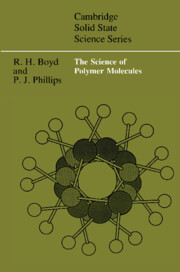Book contents
- Frontmatter
- Contents
- Preface
- 1 Polymerization: an overview
- 2 Molecular weight and molecular weight distribution
- 3 Molecular weight determination
- 4 Polymerization: kinetics and mechanism
- 5 Three dimensional architecture: conformation and stereochemical configuration
- 6 The statistical behavior of conformationally disordered chains
- 7 The interacting bond model for the average properties of coiling chains
- 8 Rubber elasticity
- 9 Solutions
- References
- Index
6 - The statistical behavior of conformationally disordered chains
Published online by Cambridge University Press: 29 October 2009
- Frontmatter
- Contents
- Preface
- 1 Polymerization: an overview
- 2 Molecular weight and molecular weight distribution
- 3 Molecular weight determination
- 4 Polymerization: kinetics and mechanism
- 5 Three dimensional architecture: conformation and stereochemical configuration
- 6 The statistical behavior of conformationally disordered chains
- 7 The interacting bond model for the average properties of coiling chains
- 8 Rubber elasticity
- 9 Solutions
- References
- Index
Summary
It is not possible to keep track of the details of the configurations of polymer molecules when they have become disordered or coiled through populating various local bond conformations. An elementary calculation is instructive. Consider a chain with three conformational states for each skeletal bond, a trans and two gauche states for example. Then a chain with N bonds capable of internal rotation will have 3N total possible conformational states. For N = 1000, a modest chain length, there are 10477 states possible! Obviously statistical descriptions are called for. This can take the form of directly finding the average value of a desired property or, in more detail, finding a distribution function for the property. For example, in the consideration of the relation between the solution viscosity and molecular weight (Section 3.3.3) it was apparent that a measure of average dimensions or size was needed. Under appropriate conditions, in a ‘theta’ solvent where phantom chain behavior obtains, the mean-square end-to-end distance can be directly calculated. Under these conditions, and where the chain length is long, it is also possible to calculate a distribution function for the probability of a chain having an arbitrary end-to-end extension. In this chapter these particular questions will be taken up, the calculation, under phantom conditions, of mean-square dimensions and the distribution function for end-to-end distance. The effects of non-self-intersection in good solvents will also be considered.
- Type
- Chapter
- Information
- The Science of Polymer Molecules , pp. 188 - 227Publisher: Cambridge University PressPrint publication year: 1993

